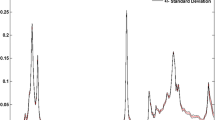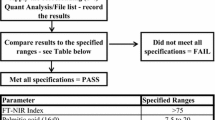Abstract
A new, rapid Fourier transform near infrared (FT-NIR) spectroscopic procedure is described to screen for the authenticity of extra virgin olive oils (EVOO) and to determine the kind and amount of an adulterant in EVOO. To screen EVOO, a partial least squares (PLS1) calibration model was developed to estimate a newly created FT-NIR index based mainly on the relative intensities of two unique carbonyl overtone absorptions in the FT-NIR spectra of EVOO and other mixtures attributed to volatile (5280 cm−1) and non-volatile (5180 cm−1) components. Spectra were also used to predict the fatty acid (FA) composition of EVOO or samples spiked with an adulterant using previously developed PLS1 calibration models. Some adulterated mixtures could be identified provided the FA profile was sufficiently different from those of EVOO. To identify the type and determine the quantity of an adulterant, gravimetric mixtures were prepared by spiking EVOO with different concentrations of each adulterant. Based on FT-NIR spectra, four PLS1 calibration models were developed for four specific groups of adulterants, each with a characteristic FA composition. Using these different PLS1 calibration models for prediction, plots of predicted vs. gravimetric concentrations of an adulterant in EVOO yielded linear regression functions with four unique sets of slopes, one for each group of adulterants. Four corresponding slope rules were defined that allowed for the determination of the nature and concentration of an adulterant in EVOO products by applying these four calibration models. The standard addition technique was used for confirmation.










Similar content being viewed by others
Abbreviations
- FT-NIR:
-
Fourier transform near infrared
- EVOO:
-
Extra virgin olive oil
- FA:
-
Fatty acid
- GC:
-
Gas chromatography
- MIR:
-
Mid-infrared
- MS:
-
Mass spectrometry
- PLS:
-
Partial least squares
- OA:
-
Oleic acid
- LA:
-
Linoleic acid
- PO:
-
Palm olein
- RO:
-
Refined olive oil
References
Frankel EN, Mailer RJ, Wang SC, Shoemaker CF, Guinard JX, Flynn JD, Sturzenberger ND (2011) Evaluation of extra-virgin olive oil sold in California. UC Davis Olive Center at the Robert Mondavi Institute, Davis
Butler J (2013) Scientists pool expertise in fight against fake olive oils, In: Olive oil times. http://www.oliveoiltimes.com/olive-oil-basics/madrid-meeting-olive-oil-authentication/36606. Accessed 28 May 2015
Olive Oil Authentication, in Scientific Workshop on Olive Oil Authentication (2013) European Commission. Madrid. http://ec.europa.eu/agriculture/events/olive-oil-workshop-2013_en.htm. Accessed 28 May 2015
International Olive Council, Trade Standard Applying to Olive Oils and Olive-Pomace Oils (2013) International Olive Council. Madrid. p 17. http://www.internationaloliveoil.org/estaticos/view/222-standards. Accessed 28 May 2015
Codex Alimentarius, Standard for Olive Oils and Olive Pomace Oils 1933–1981 (Rev. 2002–2003) (2003) Codex Secretariat. Joint FAO/WHO Food Standards Programme Codex Alimentarius Commission, ALINORM 09/32/17, Thirty-second Session, Rome, Italy, 29 June- 4 July 2009. Report Of The Twenty-First Session Of The Codex Committee On Fats and Oils, Kota Kinabalu, Malaysia 16–20 February 2009
United States Department of Agriculture: Agricultural Marketing Service, United States Standards for Grades of Olive Oil and Olive-Pomace Oil (75 FR 22363) (2010) Federal Register
European Commission, Implementing Regulation (EU) No. 1348/2013 amending Regulation (EEC) No. 2568/91 on the Characteristics of Olive Oil and Olive-Residue Oil and on the Relevant Methods of Analysis (2013) Off J Eur Union p 31–67
Standard Australian (2011) AS 5264-2011 Olive oils and olive-pomace oils. Standards Australia Sydney, Australia
Jabeur H, Zribi A, Makni J, Rebai A, Abdelhedi R, Bouaziz M (2014) Detection of chemlali extra-virgin olive oil adulteration mixed with soybean oil, corn oil, and sunflower oil by using GC and HPLC. J Agric Food Chem 62:4893–4904
Skevin D, Kralji CK, Mileti CL, Obranovic M, Nederal S, Petricevic S (2011) Adulteration of Olica virgin olive oil with edible sunflower and refined olive pomace oil. Croatian J Food Technol Biotechnol Nutr 6:117–122
Andrikopoulos NK, Giannakis IG, Tzamtzis V (2001) Analysis of olive oil and seed oil triglycerides by capillary gas chromatography as a tool for the detection of the adulteration of olive oil. J Chromatogr Sci 39:137–145
Christopoulou E, Lazaraki M, Komaitis M, Kaselimis K (2004) Effectiveness of determinations of fatty acids and triglycerides for the detection of adulteration of olive oils with vegetable oils. Food Chem 84:463–474
Aparicio R, Aparicio-Ruiz R (2000) Authentication of vegetable oils by chromatographic techniques. J Chromatogr A 881:93–104
Gurdeniz G, Ozen B (2009) Detection of adulteration of extra-virgin olive oil by chemometric analysis of mid-infrared spectral data. Food Chem 116:519–525
Parker T, Limer E, Watson AD, Defernez M, Williamson D, Kemsley EK (2014) 60 MHz H-1 NMR spectroscopy for the analysis of edible oils. Trac-Trend Anal Chem 57:147–158
Rohman A, Che Man YB, Yusof F (2014) The use of FTIR spectroscopy and chemometrics for rapid authentication of extra virgin olive oil. J Amer Oil Chem Soc 91:207–213
Rohman A, Man YBC (2010) Fourier transform infrared (FTIR) spectroscopy for analysis of extra virgin olive oil adulterated with palm oil. Food Res Internat 43:886–892
Vaclavik L, Cajka T, Hrbek V, Hajslova J (2009) Ambient mass spectrometry employing direct analysis in real time (DART) ion source for olive oil quality and authenticity assessment. Anal Chim Acta 645:56–63
Ozdemir D, Ozturk B (2007) Near infrared spectroscopic determination of olive oil adulteration with sunflower and corn oil. J Food Drug Anal 15:40–47
Baeten V, Pierna JAF, Dardenne P, Meurens M, Garcia-Gonzalez DL, Aparicio-Ruiz R (2005) Detection of the presence of hazelnut oil in olive oil by FT-Raman and FT-MIR spectroscopy. J Agr Food Chem 53:6201–6206
Lai YW, Kemsley EK, Wilson RH (1995) Quantitative-analysis of potential adulterants of extra virgin olive oil using infrared-spectroscopy. Food Chem 53:95–98
Tay A, Singh RK, Krishnan SS, Gore JP (2002) Authentication of olive oil adulterated with vegetable oils using Fourier transform infrared spectroscopy. Lebensm-Wiss Technol 35:99–103
de la Mata P, Dominguez-Vidal A, Bosque-Sendra JM, Ruiz-Medina A, Cuadros-Rodriguez L, Ayora-Canada MJ (2012) Olive oil assessment in edible oil blends by means of ATR-FTIR and chemometrics. Food Control 23:449–455
Bendini A, Cerretani L, Di Virgilio F, Belloni P, Bonoli-Carbognin M, Lercker G (2007) Preliminary evaluation of the application of the FTIR spectroscopy to control the geographic origin and quality of virgin olive oils. J Food Quality 30:424–437
Downey G, McIntyre P, Davies AN (2002) Detecting and quantifying sunflower oil adulteration in extra virgin olive oils from the Eastern Mediterranean by visible and near-infrared spectroscopy. J Agr Food Chem 50:5520–5525
Christy AA, Kasemsumran S, Du YP, Ozaki Y (2004) The detection and quantification of adulteration in olive oil by near-infrared spectroscopy and chemometrics. Anal Sci 20:935–940
Sinelli N, Cerretani L, Di Egidio V, Bendini A, Casiraghi E (2010) Application of near (NIR) infrared and mid (MIR) infrared spectroscopy as a rapid tool to classify extra virgin olive oil on the basis of fruity attribute intensity. Food Res Internat 43:369–375
Azizian H, Kramer JKG (2005) A rapid method for the quantification of fatty acids in fats and oils with emphasis on trans fatty acids using Fourier transform near infrared spectroscopy (FT-NIR). Lipids 40:855–867
Azizian H, Kramer JKG, Winsborough S (2007) Factors influencing the fatty acid determination in fats and oils using Fourier transform near-infrared spectroscopy. Eur J Lipid Sci Tech 109:960–968
Azizian H, Kramer JKG, Ehler S, Curtis JM (2010) Rapid quantitation of fish oil fatty acids and their ethyl esters by FT-NIR models. Eur J Lipid Sci Tech 112:452–462
Mossoba MM, Adam M, Lee T (2001) Rapid determination of total trans fat content - An attenuated total reflection infrared spectroscopy international collaborative study. J AOCS Internat 84:1144–1150
Maggio RM, Cerretani L, Chiavaro E, Kaufman TS, Bendini A (2010) A novel chemometric strategy for the estimation of extra virgin olive oil adulteration with edible oils. Food Control 21:890–895
Garcia-Gonzalez DL, Aparicio R (2006) Olive oil authenticity: the current analytical challenges. Lipid Technol 18:81–85
Dhifi W, Angerosa F, Serraiocco A, Oumar I, Hamrouni I, Marzouk B (2005) Virgin olive oil aroma: characterization of some Tunisian cultivars. Food Chem 93:697–701
Kiritsakis AK (1998) Flavor components of olive oil—a review. J Am Oil Chem Soc 75:673–681
Williams P (2002) Near infrared of cereals. In: Chalmers JM, Griffiths PR (eds) Handbook of Vibrational Spectroscopy. Chichester, UK, Wiley
Tran CD, Lacerda SHD, Oliveira D (2003) Absorption of water by room-temperature ionic liquids: effect of anions on concentration and state of water. Appl Spec 57:152–157
Westad F, Schmidt A, Kermit M (2008) Incorporating chemical band-assignment in near infrared spectroscopy regression models. J Near Infrared Spec 16:265–273
Acknowledgments
The authors wish to thank Mary Bolton, California Olive Ranch, for providing EVOO samples.
Conflict of interest
The authors declared no conflict of interest.
Author information
Authors and Affiliations
Corresponding authors
Additional information
Dr. John K. G. Kramer has retired from Guelph Food research center, Agriculture and Agri-Food Canada.
About this article
Cite this article
Azizian, H., Mossoba, M.M., Fardin-Kia, A.R. et al. Novel, Rapid Identification, and Quantification of Adulterants in Extra Virgin Olive Oil Using Near-Infrared Spectroscopy and Chemometrics. Lipids 50, 705–718 (2015). https://doi.org/10.1007/s11745-015-4038-4
Received:
Accepted:
Published:
Issue Date:
DOI: https://doi.org/10.1007/s11745-015-4038-4




